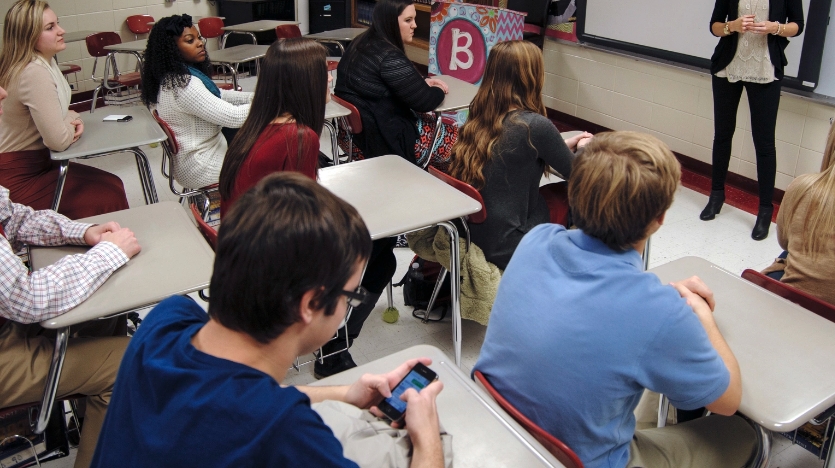Smartphones have become an integral part of our lives, but they can also pose challenges and risks when used in educational settings. In this article, we will explore how smartphones in classrooms affect students’ learning and well-being, and what policies and practices can be adopted to balance the benefits and drawbacks of these devices.
The Impact of Smartphones on Learning Outcomes
Smartphones can be useful tools for learning, as they can provide access to information, communication, and collaboration. However, they can also be sources of distraction, disruption, and cheating. Research has shown that students who use their smartphones for non-academic purposes during class time tend to have lower grades, lower retention, and lower engagement. Moreover, smartphones can also distract and affect the performance of other students who are not using them, as they can create visual and auditory noise in the classroom.
Some of the reasons why smartphones can impair learning are:
- Smartphones divide students’ attention. The human brain cannot process more than one thing at a time, so when students switch between their phones and the class material, they lose focus and depth of understanding. This can also impair their memory and recall of the information later on.
- Smartphones interfere with students’ metacognition. Metacognition is the ability to monitor and regulate one’s own learning, such as setting goals, planning strategies, and evaluating progress. Smartphones can disrupt this process by providing instant gratification, feedback, and rewards, which can reduce students’ motivation and self-regulation.
- Smartphones create a false sense of competence. Students may overestimate their knowledge and skills when they use their smartphones to look up answers, complete assignments, or take tests. This can lead to a lack of effort, critical thinking, and problem-solving.
The Impact of Smartphones on Well-being and Social Skills
Smartphones can also have positive and negative effects on students’ well-being and social skills. On one hand, smartphones can help students stay connected, informed, and entertained, which can enhance their mood, self-esteem, and resilience. On the other hand, smartphones can also expose students to cyberbullying, privacy violations, and addictive behaviors, which can harm their mental health, safety, and relationships.

Some of the factors that influence how smartphones affect well-being and social skills are:
- The content and context of smartphone use. Not all smartphone activities are equal, and some may be more beneficial or harmful than others. For example, using smartphones to access educational or health-related information, or to communicate with supportive friends and family, can have positive outcomes. However, using smartphones to consume violent or sexualized media, or to engage in online harassment or sexting, can have negative outcomes.
- The amount and timing of smartphone use. The frequency and duration of smartphone use can also affect well-being and social skills. For instance, using smartphones excessively or compulsively can interfere with sleep, physical activity, and academic performance, which can impair health and happiness. Likewise, using smartphones at inappropriate times, such as during class, meals, or bedtime, can disrupt social interactions, etiquette, and intimacy, which can damage relationships.
- The individual and environmental factors. The impact of smartphones on well-being and social skills can also vary depending on the personality, age, and culture of the user, as well as the norms, expectations, and policies of the school and society. For example, some students may be more prone to smartphone addiction, anxiety, or depression than others, and some schools may have more strict or lenient rules regarding smartphone use than others.
The Policies and Practices for Smartphones in Classrooms
Given the mixed effects of smartphones on learning and well-being, it is important to find a balance between allowing and restricting smartphone use in classrooms. There is no one-size-fits-all solution, as different schools and students may have different needs and preferences. However, some general guidelines and recommendations are:
- Involve all stakeholders in the decision-making process. The policies and practices for smartphones in classrooms should be based on the input and feedback of teachers, students, parents, and administrators, as they are the ones who are directly affected by them. The policies and practices should also be clear, consistent, and fair, and communicated to all parties.
- Consider the educational purpose and value of smartphone use. Smartphones should be used in classrooms only when they can enhance the learning objectives and outcomes, and not when they can distract or detract from them. Teachers should design and implement lessons and activities that integrate smartphones in meaningful and engaging ways, such as using them for research, collaboration, or assessment. Teachers should also monitor and evaluate the effectiveness and impact of smartphone use on student learning.
- Promote the responsible and ethical use of smartphones. Smartphones should be used in classrooms in a way that respects the rights, privacy, and safety of oneself and others, and that follows the rules and regulations of the school and the law. Students should be taught and encouraged to use smartphones in a manner that is appropriate, respectful, and safe, and to avoid using them for cheating, bullying, or illegal activities. Students should also be aware of the consequences and sanctions for misusing smartphones.
- Support the well-being and social skills of smartphone users. Smartphones should be used in classrooms in a way that supports the physical, mental, and emotional health of students, and that fosters positive and constructive social interactions. Students should be guided and assisted to use smartphones in a moderate and balanced way, and to avoid using them excessively, compulsively, or addictively. Students should also be given opportunities and spaces to interact with their peers and teachers face-to-face, and to develop their social and emotional skills.
Conclusion
Smartphones are powerful devices that can have both positive and negative effects on students’ learning and well-being. Therefore, it is essential to have policies and practices that can optimize the benefits and minimize the drawbacks of smartphones in classrooms. By involving all stakeholders, considering the educational purpose and value, promoting the responsible and ethical use, and supporting the well-being and social skills of smartphone users, schools can create a learning environment that is conducive, safe, and enjoyable for everyone.


















